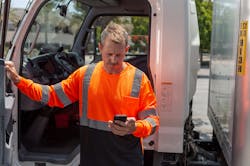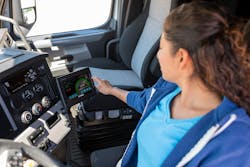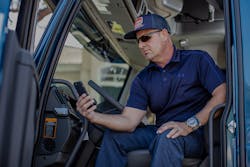Used to track vehicle health, driver behaviors, collisions, routing, dwell time, fuel costs, temperature sensors, or asset location, the possibilities of today’s modern telematics devices are endless—until they’re not.
One pain point that fleets face is when their back-office and in-cab technologies don’t communicate, making the task of automating and then analyzing data incredibly daunting. Many of today’s telematics providers recognize that fragmented data points can pose problems and frustrate fleets. The good news is they acknowledge the need and are working toward making truly open platforms a reality for end users.
See also: During these disruptive times, technology can keep fleets prepared
“We as software vendors to the industry need to provide a platform to connect any telematics device to any back-office system,” explained Chris Orban, VP and business area manager of supply chain insights at Trimble Transportation. “I don’t care if you’re using Geotab, PeopleNet, Omnitracs, Samsara, Platform Science, or the driver’s mobile phone tagged to a Bluetooth tether in the cab for ELD compliance, there are a million different solutions out there, but you still need to get that driver information and you need to be able to get information from that driver.”
“Trimble and other information technology providers’ job is to make sure there is a platform to connect those different devices in a fair way—not favoring one over the other—and connect them to back-office solutions,” Orban added.
Expanding these platforms to meet fleet needs will become that much more critical as technologies and industrywide adoption continue to grow.
Telematics growth
Rajesh Rudraradhya, chief technology officer at Lytx, has seen the use of video and telematics progress greatly in the commercial vehicle space over the last 10 years or so. At the start of the telematics scene in trucking, the market was split into two parts—video telematics and GPS tracking.
“In the last decade, the convergence of video telematics has happened, so the market has gone mainstream,” Rudraradhya explained. “The reason why it’s gone mainstream is the ROI has been well-established in the industry. All the fleets I talk to rely more and more on the data and the technology that generates the data for their operations.”
By implementing video telematics, for example, a fleet could see a 50% to 80% reduction in collision costs and about 20% reduction in fueling costs, Rudraradhya pointed out.
Although the ROI can be high, the three main fleet classes of data—safety, CAN bus, and compliance—remain completely fragmented when it comes to how fleets have access to all that information, Rudraradhya said. He sees some enterprise fleets use Lytx for video, another system for their ELDs and operational data, and then their own in-house systems for dispatch and delivery management.“They are optimizing for one variable at a time from each one of these individual systems as opposed to optimizing for their end-to-end system,” Rudraradhya explained. “When you bring all that data together, you can optimize it from an end-to-end perspective.”
Bringing all this data into one place for fleets could help them better maximize some of their key performance indicators centered on routing, fuel usage, safety, and hours of service, for example. That’s important for suppliers to keep in mind, as the global commercial vehicle telematics market is projected to grow from $40.18 billion in 2021 to $158.1 billion by 2028, according to data from Fortune Business Insights.
The main driving forces behind this growth are fleet owners and OEMs, explained Paul Sniegocki, chief technical officer for Clarience Technologies. In addition to fleet operators, insurers are more interested in understanding the insights and the data that is emitted from telematics solutions.
“Many government regulations are being pushed now in the direction of safety and security,” Sniegocki said. “DOT and NHTSA pay certain attention to statistics with commercial vehicles. Telematics plays a huge opportunity to enhance safety over the road. All of this is tied to connectivity between vehicles and the ecosystems in which they operate.”
Fleet data needs
Ed Reardon is the general manager of transportation safety and compliance for CF Logistics (CFL). The company, owned by Giorgio (GFX), produces mushrooms and transports the product via a private fleet of 90 trucks and refrigerated units. As general manager of fleet safety and compliance for both GFX and CFL, Reardon is responsible for the private fleet’s in-cab technologies and ELD compliance.
The fleet uses a stand-alone system for its ELDs, a separate provider for its transportation management system (TMS), and a completely different solution for its inventory and invoicing system.
“The three of them don’t even know the others exist,” Reardon stressed. “That leaves us a mess, and there is no way of getting out of that right now.”
Reardon pulls most of the data he needs for fleet safety and operations from driver logs. The ELDs allow Reardon to extract data in a workable format and provide insights so he can see exactly what drivers’ days look like, which helps the fleet better serve customers. When it comes to running reports on asset utilization and cost efficiencies, however, Reardon is still using a time-consuming manual data input process.
“Most of all this in-cab technology and telematics in the industry tends to be very good; integration is probably the biggest albatross that we have,” Reardon told FleetOwner. “The person making the decision on the in-cab technology that is going in the trucks is different than the person making the decision for the back office. When that happens, there is no discussion about whether the two programs talk. If that conversation never takes place, your telematics is almost useless other than what you bought it for.”
See also: During these disruptive times, technology can keep fleets prepared
One of the biggest gains for the GFX/CFL fleet that Reardon has found has been derived by routing data from driver logs to determine hold-ups at customer facilities.
“If we have a route with three stops along the way and the first stop on that route always holds us up, we can’t prove it unless we pull it out of the ELD,” he explained. “We take that data and provide it to a customer and say, ‘We understand that everybody has labor shortages and supply chain issues; however, you are the first stop on this route and in order for us to continue our service with you, you need to get us unloaded in a proper amount of time.’”
That kind of data, Reardon added, is invaluable when communicating with and holding customers accountable.
The private fleet also leverages ELD data to evaluate how newer drivers are running their routes compared to more seasoned veteran drivers. “We can look at the e-log scenarios and figure out what the drivers are doing incorrectly,” he said. “It may just be a fact that a driver stops for rest at one place and at fuel for another rather than combining the two.”
Reardon also relies on ELD data to track and optimize miles per gallon and fuel usage. Much of the data that Reardon collects is used to massage safety bonuses and training programs for drivers.
Keeping up with safety metrics
In today’s trucking operations, safety and efficiency are closely tied. Part of that means keeping drivers informed on where they are going and giving drivers proper pickup and delivery information, Trimble’s Orban explained. This type of information could help prevent drivers from dwelling outside a receiver’s yard for hours—creating not only inefficiencies but also potential fatigue situations.
“We can look at [the data] and say, ‘We understand the dwell times on these locations along your route. Instead of just sitting frustrated outside waiting for the two hours that it’s going to take to get into the drop yard, maybe take a nap at the truck stop a half hour beforehand and get to the facility 20 minutes early instead of two hours. Arrive rested, ready to make that delivery, and then start your 10-hour break once that delivery is made,’” Orban said.
When working with fleets, Orban sees a huge push for data on dwell time, trip management, and improved routing. Trimble also helps fleets analyze critical safety events, like hard braking, roll stability control, and following too closely to help identify potential outliers.
“One example I always use is that I am not super worried about a driver who has a hard-braking event in rush hour around Atlanta, because someone probably cut them off, and we can verify that with a connected video device,” Orban pointed out. “I am very worried about the driver who has a left, right, left, right lane departure on a rural road in Texas at 3 a.m. because that’s indicative of some fatigue behavior.”
See also: How to select anti-distracted driving technologies
As a fleet safety manager, Reardon doesn’t rely on certain metrics, like hard-braking occurrences, to scold his drivers. That’s because he has been able to prove—through video telematics—that 95% of the hard-braking videos were because the driver made every attempt to operate safely. Instead, Reardon keeps track of near-misses, actual collisions, and speeding events to coach drivers.
“An actual collision gives you an entire story of what actually happened,” Reardon said, adding that he can go back through video data and obtain a minute-by-minute activity report on what the truck did just prior to, during, or immediately after a collision.”
“Not everything is a discipline, especially with how hard it is to get drivers,” he added. “You don’t want to fire everybody. Sometimes we have drivers on the force that just make mistakes, so a lot of it is a coaching opportunity.”
Reardon also pulls data from devices to help dispatch personnel score drivers for safety bonuses. When it comes to keeping his drivers and assets safe, his main priority is speeding.
“We give our drivers a lot of liberty as far as the pedal is concerned,” Reardon said. “We have our trucks governed at 68 on the pedal and 70 on the cruise. So, we give the drivers the ability to stay with traffic, but we can see when they are not controlling the truck, and we get speed alerts from the ELD that the truck has been speeding for more than 10 minutes over the posted speed limit; that is useful data for us.”
Lytx’s Rudraradhya often seesfleets put self-improvement plans in place both for their drivers and to optimize their daily routes. Lytx offers a driver app that allows the company to set parameters for specific drivers and routes. The driver also has the option to go in and work with fleet managers to modify those parameters based on real-world scenarios that work best for them.For coaching, Lytx allows fleet managers to set alerts for certain types of driver behaviors, which drivers can self-correct before alerts are sent to the back office. For example, if a driver is eating, drinking, or smoking, an in-cab device will notify the driver in real time. If the driver changes his or her behavior right away, managers aren’t informed.
“We allow drivers to change their behavior on their own, which, in turn, significantly reduces the burden from fleets so they don’t have to coach their drivers,” Rudraradhya said. “It’s a self-sustaining loop. Based on Lytx data, we see that 80% of the drivers self-correct.”
One trend that Trimble’s Orban sees is a push toward more apps for drivers, as well as drivers asking for certain apps and functionality on their devices. He did, however, emphasize the importance of overloading both drivers and back-office staff with too many apps and alerts.
Ultimately, anything that gives the driver a choice goes a long way for the fleet, Orban added.
An ongoing evolution
Tracing back vehicle connectivity to when it first started—some 20 years ago—it was all about geolocation and asset tracking, according to Nada Jiddou, EVP and general manager for Road Ready advanced telematics at Clarience. Then came the introduction of smart devices, IoT principles, data analytics, and other capabilities in the connected vehicle ecosystem.
“That evolution of connectivity into IoT solutions and a telematics system has been key in the next inflection point within the industry, where data becomes the driver for connectivity, and the smart network is also more in demand now,” Jiddou explained. “Users are no longer just interested in where the asset is, but they also want to know the health state of the asset and what exactly is wrong with the asset or the vehicle for them to provide comprehensive maintenance and preventive maintenance.”
As the trucking industry continues to face pressures from a struggling global supply chain, preventive maintenance practices become more important in keeping older assets in operation longer, according to telematics provider ConMet.
“In the face of these challenges, fleets are seeking new methods for managing their aging assets cost-effectively and with as little disruption to their business as possible,” ConMet stated. “This is pushing the industry toward investing in more sophisticated telematics systems.”
Amid these developments and the need for more sophisticated systems, data privacy and management are also at the forefront of fleet concerns, Jiddou added.
Because no one supplier can offer it all today, many telematics companies are intent on integrating their systems with other industry-leading providers. Clarience Technologies, for example, has acquired several telematics companies, including Road Ready, Fleetilla, and P.S.I., among several others, to offer a wider range of solutions to fleets.
“These partnerships allow us to offer capabilities that we alone might not be able to do,” Jiddou added. “It allows us to bring in all the data from the different providers and translate it into meaningful data that we can show on a single pane of glass for the fleet depending on what they are interested in at any given time.”
Trimble’s Orban agreed that absolute integration will be key moving forward.
“Fleets have brought it up, shippers have brought it up, everybody wants integration and wants the data to flow smoothly,” he said. “Nobody wants the driver to enter anything manually. I want the driver spending all their time behind the wheel, not worrying about whether they mistyped a bill of lading or whether they put in a correct trailer number.”
Alex Jensen, senior manager of brand and communications at Lytx, also reiterated the importance of having open platforms to drive innovation.
“There’s a lot of market stress right now with supply chain and driver shortage,” Jensen said. “That’s the advantage of an open platform—you are sharing the data with a larger community and benefiting from the network, not hoarding the data, and innovating in your own laboratory all by yourself.”
CFL’s Reardon is optimistic about seeing many smaller telematics companies being absorbed by some of the bigger players to solve the integration problem.
“Everyone I talk to in this industry has the same problem,” Reardon said. “Fleets need to provide upper-level management with the data they need to run the business and give the finance and operations people the data we are going to run on and survive on. Everything has to talk. Right now, there is so much that doesn’t talk.”
About the Author

Cristina Commendatore
Cristina Commendatore is a past FleetOwner editor-in-chief. She wrote for the publication from 2015 to 2023.




